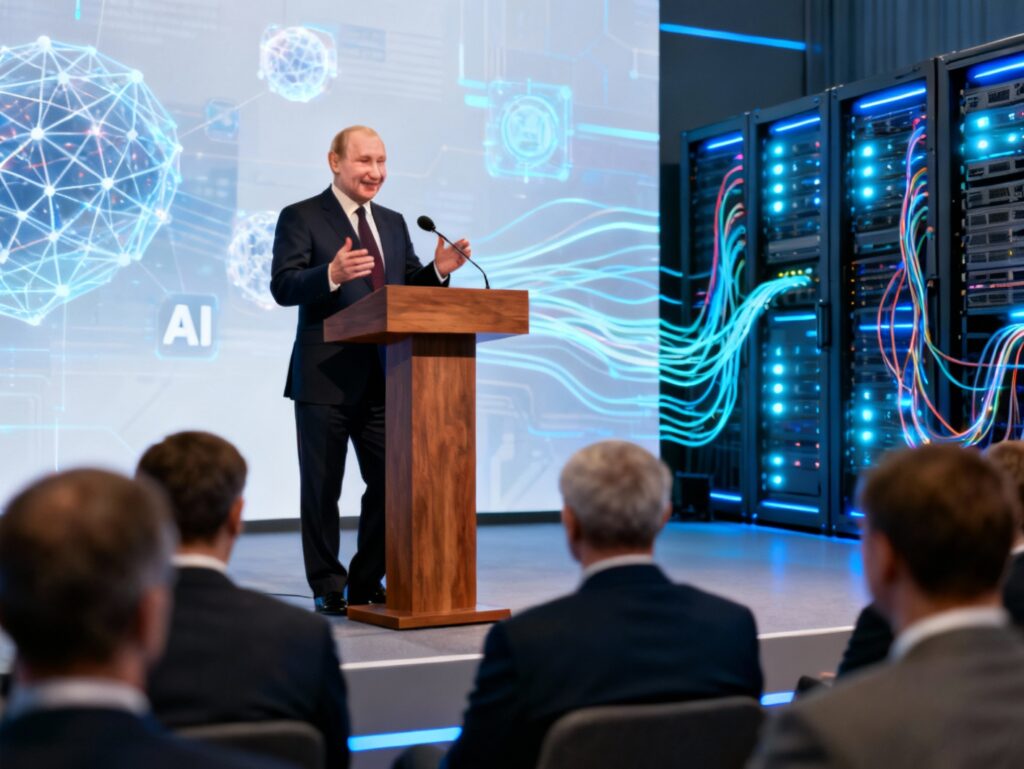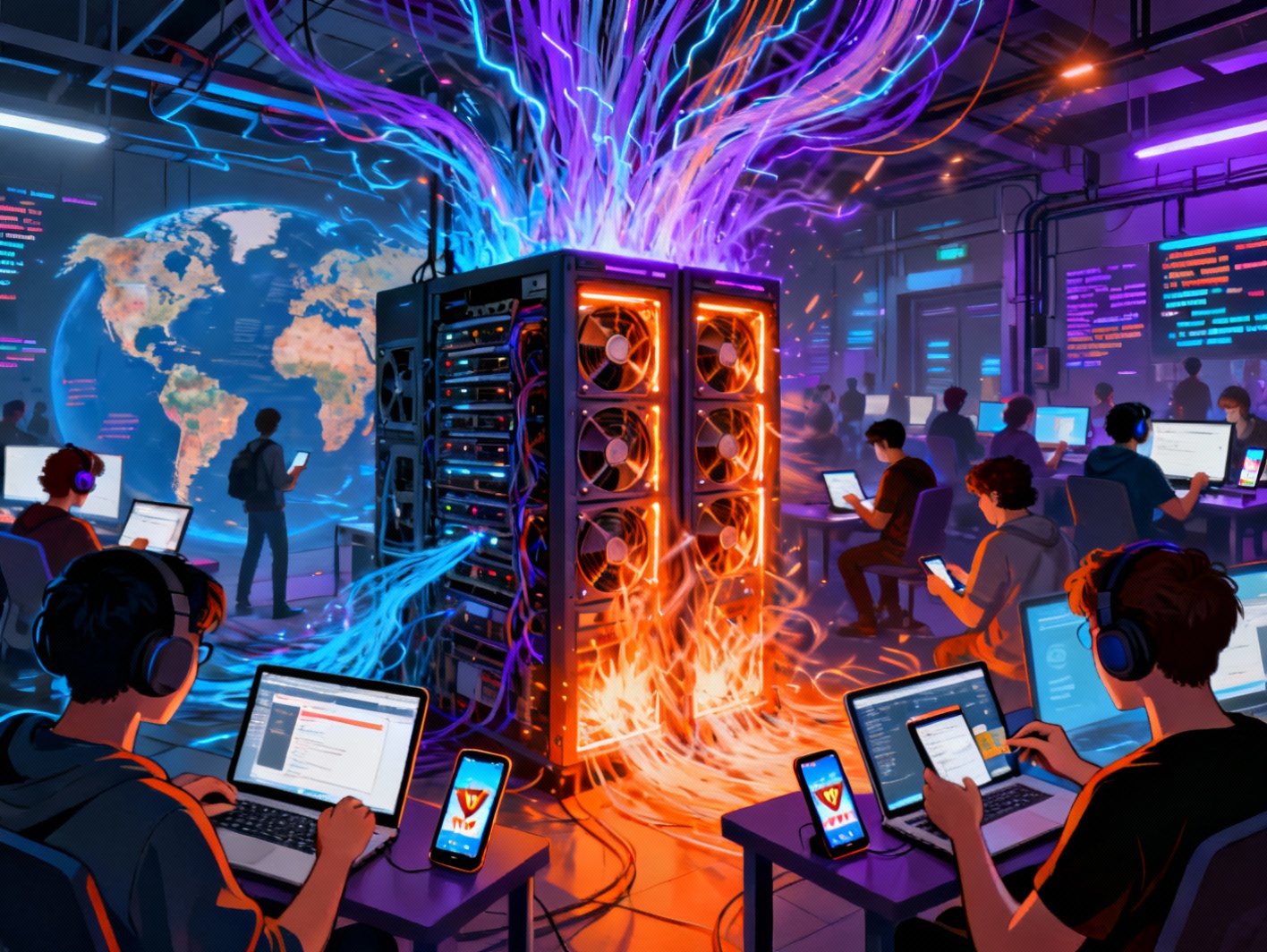
Table of Contents
On November 19, 2025, President Vladimir Putin announced the formation of a national task force aimed at accelerating the development of Russia’s generative artificial intelligence (AI) technologies. This move reflects Russia’s broader ambition to enhance its technological sovereignty and reduce its reliance on foreign AI models. The initiative marks a critical milestone in Russia’s digital transformation, targeting both national security and economic modernization. With geopolitical tensions rising and technological competition intensifying, Russia sees AI not just as a tool for innovation, but as a key element of its strategic independence and global relevance.
The Strategic Imperative for Domestic AI Development
Russia’s pursuit of native AI technologies is deeply rooted in both geopolitical strategy and technological self-reliance. President Putin has consistently emphasized the importance of securing the country’s sovereignty in data, algorithms, and digital infrastructure. With increasing global tensions, particularly with Western powers, the Kremlin views reliance on foreign large language models (LLMs) as a national security risk. These models, often developed by companies in the United States and its allies, are not only opaque in design but can be influenced or even restricted based on political interests.
Furthermore, LLMs can reflect foreign value systems and biases that may contradict Russia’s cultural and ideological narratives. Russia fears that without full control over its AI technologies, it may lose its ability to assert its perspectives and maintain information autonomy. The risk is not just technical—it is ideological and strategic. By developing indigenous AI, Russia seeks to embed its own value framework and governance protocols into these systems, ensuring compatibility with its national objectives. Technologically, creating homegrown AI solutions also enables better integration into domestic infrastructure, aligning with local data, language features, and user cases more effectively. In short, AI stands at the crossroads of Russia’s drive for national strength, making it a vital asset in an increasingly divided and digital world.
Establishment of the National AI Task Force
The formation of Russia’s national AI task force signifies a top-down mobilization of resources to assert leadership in generative AI. Established under President Putin’s directive, this inter-agency initiative is tasked with aligning efforts across the government, private sector, and academic institutions. The goal is to coordinate research, fund high-impact projects, and build sustainable AI ecosystems throughout Russia. Instead of piecemeal projects scattered across different institutions, the task force creates an integrated platform for AI development that aligns with national priorities.
The task force’s main responsibilities include developing policy frameworks to guide the ethical and secure deployment of AI technologies. It will supervise data-sharing policies to support large-scale model training and optimize regulation to encourage innovation while preventing misuse. Additionally, it acts as a central repository for defining technical standards in training data, model safety, and infrastructure interoperability. One of its key operational roles is to promote collaboration between Russia’s major tech companies such as Sberbank, Yandex, and Rostelecom, and government-backed research centers.
This collective approach is essential for building models that are competitive with global counterparts. The structure also fosters agile responses to international sanctions and technological embargoes, which may affect access to critical tools or knowledge. By consolidating expertise and setting a unified direction, the AI task force not only speeds up innovation but guards against fragmented or duplicative efforts among stakeholders.
Infrastructure Development: Data Centers and Energy Solutions
To support the ambitious generative AI program, Russia plans a major expansion of its data center infrastructure. These facilities are critical for training and deploying LLMs, requiring enormous computing power and reliable energy supplies. Unlike many Western nations that rely on centralized, hyper-scale data centers, Russia aims for a distributed network model. This includes the construction of regional AI clusters that can operate independently and adapt to local needs, improving accessibility and resilience.
A standout feature of this infrastructure initiative is the planned integration of small-scale nuclear power plants. These compact energy sources are intended to provide a stable and secure electricity supply to AI data centers, especially in remote regions. Nuclear-powered data centers could significantly reduce dependencies on fossil fuels and insulate operations from cyber or physical threats targeting national energy grids. This solution is both strategic and practical, especially considering Russia’s vast geography and existing expertise in nuclear energy.
These advanced data hubs will serve as foundational components for the country’s AI capabilities, supporting model training, edge computing, and cloud-based AI services. In addition, Russia anticipates that these investments will catalyze related technological fields such as quantum computing and high-throughput data storage. Ultimately, the data center plan is not just about infrastructure, but about creating a self-sustaining digital ecosystem immune to external disruption.
Current State of Russia’s AI Landscape
Despite significant efforts, Russia trails major global players such as the United States and China in the AI domain. Both these nations have leveraged unparalleled access to talent, funding, and worldwide data flows to develop industry-leading models like ChatGPT and Ernie Bot. Russia’s journey into generative AI is more recent and hindered by systemic limitations such as constrained R&D budgets and sanctions that limit access to modern microchips and cloud services.
Nevertheless, domestic champions are beginning to emerge. Sberbank’s Gigachat model represents Russia’s foray into competitive LLMs. Designed for Russian language users, it integrates locally relevant datasets, aligning more closely with regional linguistic and cultural nuances. Similarly, Yandex has developed GPT-class models optimized for search and virtual assistant applications, demonstrating technical viability in consumer-facing services. Tinkoff, Gazprom Neft, and the Russian Academy of Sciences are also initiating AI projects, focusing on finance, energy, and scientific research.
While these initiatives are promising, they lack the scale and global datasets that companies like Google and OpenAI operate with. However, Russia is focused on building models that serve national priorities rather than achieving global dominance. By prioritizing local effectiveness over international competition, Russian LLMs are positioned as secure, language-conscious, and mission-specific tools. Still, the challenge remains to close the capability gap quickly as AI continues to evolve at unprecedented speed.
Economic Projections and Sectoral Integration
The economic potential of artificial intelligence in Russia is substantial. Projections estimate that by 2030 AI could contribute over 11 trillion roubles to Russia’s Gross Domestic Product (GDP). This figure represents a transformative force in multiple sectors—from industrial automation to personalized healthcare and real-time logistics management. To realize these gains, the government, under the national task force’s guidance, is rolling out comprehensive strategies to embed AI across both public and private domains.
In the industrial sector, AI technologies are being deployed to enhance predictive maintenance, optimize supply chains, and improve safety through real-time monitoring. In transportation, smart traffic systems and autonomous vehicle research are underway, with the goal of reducing urban congestion and improving inter-regional connectivity. Healthcare is another priority, where AI is being used to enhance diagnostics, manage hospital flows, and support pharmaceutical research.
In the public sector, the introduction of AI-powered systems in tax collection, legal document analysis, and citizen services is expected to deliver substantial efficiency gains. By automating repetitive tasks and enhancing data-driven decision-making, AI will make governance faster and more responsive. Russia is also funding AI incubators and research labs to ensure ongoing innovation. The economic reward lies not just in productivity, but in global competitiveness, where leading countries are increasingly those who master AI across society.
Challenges and Future Outlook
Russia faces several substantial challenges in its journey toward AI self-sufficiency. Chief among them are international sanctions, which have cut off access to cutting-edge semiconductor hardware—crucial for training complex AI models. High-performance GPUs and specialized chips like TPUs remain difficult to import, creating bottlenecks for domestic developers. While Russia is investing in local chip production, results will take years to match global standards.
Another key issue is the availability of skilled AI talent. Although Russia has a solid base of mathematicians and data scientists, the brain drain to tech companies abroad has limited the country’s ability to sustain competitive innovation. To reverse this, new university programs, incentives for returning researchers, and visa programs for aligned nations are being implemented.
Finally, the geopolitical landscape poses constraints and opportunities. While Western ties have weakened, Russia is deepening its collaboration with BRICS and Eurasian states. Joint AI research initiatives, shared computing grids, and multinational data partnerships are being explored to strengthen technical capacity. However, AI development is a fast-paced and capital-intensive field, and sustained commitment across political and technical dimensions is critical. The future outlook depends on how well Russia balances isolation-resilience with collaborative leverage in the global AI ecosystem.
Conclusions
Russia’s launch of a national task force for generative AI development reflects a clear commitment to technological independence and strategic resilience. By focusing on indigenous model creation, distributed infrastructure, and economic integration, the initiative lays the foundation for an AI-powered transformation of society. While the road ahead involves overcoming sanctions, hardware limitations, and talent shortages, the nation is taking concrete steps to build capacity from within.
Through cooperation across government, industry, and academia—and potentially with partners like the BRICS countries—Russia aims to become a significant force in the global AI landscape. The move is not just about catching up with world leaders; it’s about crafting an AI framework that serves national interests and ensures autonomy in the digital age.










